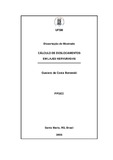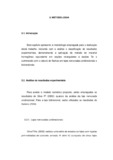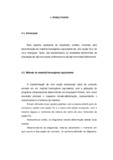| dc.creator | Borowski, Gustavo da Costa | |
| dc.date.accessioned | 2006-12-13 | |
| dc.date.available | 2006-12-13 | |
| dc.date.issued | 2005-02-25 | |
| dc.identifier.citation | BOROWSKI, Gustavo da Costa. CALCULATION OF DISPLACEMENTS IN WAFFLES SLABS. 2005. 128 f. Dissertação (Mestrado em Engenharia Civil) - Universidade Federal de Santa Maria, Santa Maria, 2005. | por |
| dc.identifier.uri | http://repositorio.ufsm.br/handle/1/7751 | |
| dc.description.abstract | This work has as main objective to contribute for the development of a methodology capable to determine through numerical simulations the displacements in waffles slabs, submitted to uniformly distributed loading. It was analyzed a unidirectional waffle slab and another bidirectional, applying the method of the homogeneous equivalent material for the
determination of the behavior of the transversal section of the ribbing. The materials had been characterized from the recommendations of NBR 6118 and also for the analyses carried through the authors of the reference slab, that will serve for the validation of this work. With the job of finite
elements of bar and hexaedrals with twenty nodes, it was simulated the structure of the unidirectional waffle slab, getting as main result, the displacements at the center span. One evidenced that the model with hexaedrals finite elements of twenty we represented of satisfactory form the behavior of the structure. For the finite elements of bar, similar curves
with behavior the actual structure, but with values of displacements below of the experimental values was obtained. On new analysis, it was verified that the used finite element did not consider all the characteristics of the T section, identified a correction factor, resultant of the ratio of the width table and the ribbing width, to be applied to the obtained values, generating a corrected load-displacement diagram. These last results had presented compatible values with the real structure. For the analysis of the bidirectional waffle slab, the option for the use of assay carried through in
reduced model was made, applying the method with bar finite elements, through a grate. In the determination of the equivalent homogeneous material had been grouped the ribbings in bands, in accordance with the similarity of the form and the reinforcemente, generating a mechanical behavior for each band. The results also had been corrected by the
correction factor, coming close themselves to the experimental values, except in edges of the slab where the influence of the negative moments are bigger. Thus, it was contributed for the development of a methodology
capable to calculate the displacements in the waffle slabs. | eng |
| dc.format | application/pdf | por |
| dc.language | por | por |
| dc.publisher | Universidade Federal de Santa Maria | por |
| dc.rights | Acesso Aberto | por |
| dc.subject | Construção civil | por |
| dc.subject | Estrutura de concreto | por |
| dc.subject | Concreto armado | por |
| dc.subject | Lajes nervuradas | por |
| dc.title | Cálculo de deslocamentos em lajes nervuradas | por |
| dc.title.alternative | Calculation of displacements in waffles slabs | eng |
| dc.type | Dissertação | por |
| dc.description.resumo | Este trabalho tem como objetivo principal contribuir para o
desenvolvimento de uma metodologia capaz de determinar através de simulações numéricas os deslocamentos verticais em lajes nervuradas, submetidas a carregamentos uniformemente distribuídos. Foi analisada uma laje nervurada unidirecional e outra bidirecional, aplicando-se o método do material homogêneo equivalente para a determinação do
comportamento da seção transversal da nervura. Os materiais foram caracterizados a partir das recomendações da NBR 6118 e também pelos ensaios realizados pelos autores das lajes de referência, que servirão para a validação deste trabalho. Com o emprego de elementos finitos de barra e isoparamétricos com vinte nós, simulou-se a estrutura da laje
nervurada unidirecional, obtendo como principal resultado, a flecha no centro do vão. Constatou-se que o modelo com elementos finitos cúbicos de vinte nós representou de forma satisfatória o comportamento da estrutura. Para os elementos finitos de barra, foram obtidas curvas com comportamento semelhantes a estrutura real, mas com valores de deslocamentos bem abaixo dos valores experimentais. Numa análise minunciosa, foi verificado que o elemento finito utilizado não considerava todas as características da seção Te. Então, identificou-se um fator de correção, resultante do quociente entre a largura da mesa e a largura da nervura, para ser aplicado aos valores obtidos, gerando um diagrama
carga-deslocamento corrigido. Estes últimos resultados obtidos
apresentaram valores compatíveis a estrutura real. Para a análise da laje nervurada bidirecional foi feita a opção pela utilização de ensaio realizado em modelo reduzido, aplicando o método com elementos finitos de barra, através de uma grelha. Na determinação do material homogêneo equivalente foram agrupadas as nervuras em faixas, de acordo com a
similaridade da forma e da armadura, gerando um comportamento mecânico para cada faixa. Os resultados obtidos também foram corrigidos pelo fator de correção, aproximando-se dos valores experimentais, salvo nos bordos da laje em que a influência dos momentos fletores negativos é
maior. Assim, contribuiu-se para o desenvolvimento de uma metodologia capaz de calcular as flechas nas lajes nervuradas. | por |
| dc.contributor.advisor1 | Rizzatti, Eduardo | |
| dc.contributor.advisor1Lattes | http://buscatextual.cnpq.br/buscatextual/visualizacv.do?id=K4707100J1 | por |
| dc.contributor.referee1 | Lopes, Maria Isabel Pimenta | |
| dc.contributor.referee1Lattes | http://buscatextual.cnpq.br/buscatextual/visualizacv.do?id=K4797990E8 | por |
| dc.contributor.referee2 | Gomes, Herbert Martins | |
| dc.contributor.referee2Lattes | http://buscatextual.cnpq.br/buscatextual/visualizacv.do?id=K4791640J7 | por |
| dc.creator.Lattes | http://buscatextual.cnpq.br/buscatextual/visualizacv.do?id=K4762908J8 | por |
| dc.publisher.country | BR | por |
| dc.publisher.department | Engenharia Civil | por |
| dc.publisher.initials | UFSM | por |
| dc.publisher.program | Programa de Pós-Graduação em Engenharia Civil | por |
| dc.subject.cnpq | CNPQ::ENGENHARIAS::ENGENHARIA CIVIL | por |




